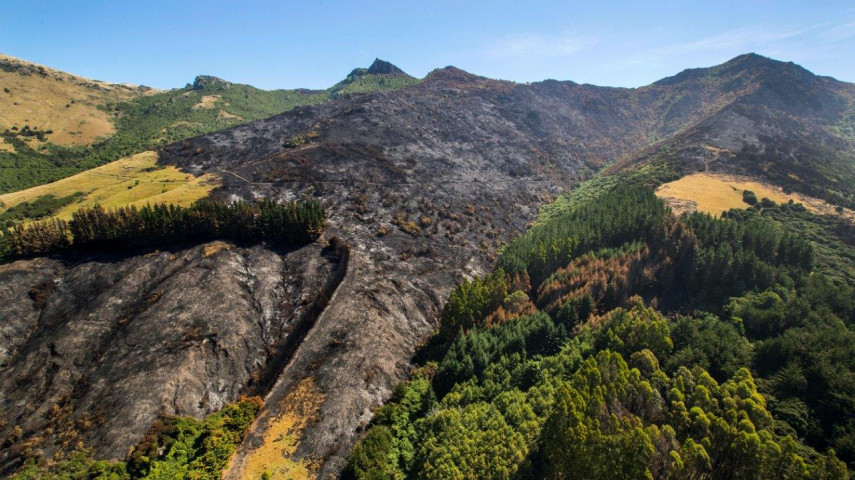A devastating fire burned more than 1600 hectares of land on the Port Hills in February 2017, claiming the life of one firefighter and destroying nine homes and two other structures.

Initially there were two fires that started on Monday 13 February, but they merged into one, cutting across the boundary from Selwyn District into Christchurch City.
At its peak there were up to 150 people on the ground battling the blaze and 14 helicopters and three fixed wing aircraft. More than 36 agencies were involved in the firefighting effort.
Several hundred people were evacuated and a state of local emergency was in place for Christchurch and Selwyn for two weeks, ending on 1 March.
The Christchurch Adventure Park(external link) reopened in December 2017.
The investigation focused on information flow and the timing of the state of emergency declaration.
Key findings:
- If the potential consequences of the two fires merging and the risk of evacuations had been considered and communicated to the Christchurch EOC earlier it would have enabled the EOC to inform residents that evacuations may be required. This would have allowed residents to prepare for evacuations, including making arrangements for pets and removing important possessions. It would also have enabled better planning and management of the evacuation and cordon processes.
- The information flow to affected residents and the wider public during the initial days of the fires was not always timely or sufficient and this created anxiety in the community.
The review also found that if the declaration of a state of local emergency had been made earlier, this would have raised public awareness of the potential danger, as well as providing confidence that all available resources were being used to fight the fires. Making public confidence one of the criteria for declaring a state of emergency is one of the recommendations from the national review into the structure and operation of Civil Defence Emergency Management.
We applied some of the lessons from the Port Hills fire during the state of emergency that was declared in July 2017 due to flooding with positive results.
Port Hills fires lessons learnt report [PDF, 531 KB]
The review into the Port Hills fires makes recommendations on how Fire and Emergency New Zealand (FENZ) will carry out its duties in the future.
FENZ requested an independent review into the operational response to the Port Hills fires. The review was conducted by Alan Goodwin of the Australasian Fire and Emergency Services Authority Council (AFAC).
The focus of the review was to make recommendations on how new organisation will carry out its duties in the future.
You can read more about the review and its findings on the FENZ website(external link)
FENZ has also released the outcome of its investigation into the cause of the fires, which it says are undetermined.
Projects to deal with landslip mitigation, replanting and reducing the likelihood of sediment runoff into waterways are included in the Port Hills Recovery Plan.
Feedback from affected property owners, the community and those with a special interest or involvement in the Port Hills was instrumental in developing the plan, which Christchurch City Council adopted on 8 June 2017.
Some work has already been completed, while medium-term measures identified will need to be considered for funding in the 2017/18 Annual Plan and longer term projects the 2018-2028 Long Term Plan.
As well as looking at landslip mitigation, replanting and efforts to reduce the likelihood of sediment runoff into waterways, the plan also touches on the fire response itself.
Port Hills Recovery Plan [PDF, 4.7 MB]
Port Hills Recovery Plan Discussion Document [PDF, 894 KB]
Recovery team weekly reports
Below are links to the weekly reports from the Christchurch recovery team. Some information has been redacted because it contains personal information or material that is commercially sensitive.
- Port Hills Fire Recovery report week ending 17 March 2017 [PDF, 304 KB]
- Port Hills Fire Recovery report week ending 24 March 2017 [PDF, 382 KB]
- Port Hills Fire Recovery report week ending 31 March 2017 [PDF, 407 KB]
- Port Hills Fire Recovery report week ending 7 April 2017 [PDF, 413 KB]
- Port Hills Recovery report week ending 5 May 2017 [PDF, 385 KB]
Recovery works and how people are contributing to the Port Hills recovery effort.
Volunteers get digging
Volunteers have hit the ground this winter, getting stuck in planting about 7200 native plants in the fire-affected area.
About 6500 trees and plants planted by volunteers in Port Hills reserves over the past 15 years were destroyed in February’s devastating wildfire but in an amazing community effort more than that have been planted over winter. They have also made 10,000 plastic cages to protect the fledgling plants so they get the best growing start possible.
Read more about the volunteer effort on Newsline(external link).
Ohinetahi Reserve
The Port Hills fires have seriously impacted the Summit Road Society’s Ohinetahi Reserve, with 83 hectares of native reserve burnt. Up to 1.3km of fencing also needs replacing.
Find out more about how you can help Summit Road Society volunteers to preserve the landscape and remaining biodiversity at the Summit Road Society’s webpage.(external link)
Links and presentations about the fire and fire protection.
Ecological impact of the fire
At a meeting in March 2017, people with expertise and an interest in the ecology of the Port Hills met to discuss the impact of the fire and look at regeneration and protection measures.
Below are copies of presentations by Dr Tim Curran, senior lecturer in ecology at Lincoln University, and Professor David Norton from the School of Forestry at University of Canterbury.
Port Hills Complex Fire 2017 Ecological Stakeholders Presentation PowerPoint David Norton [PDF, 2.4 MB]
Port Hills Complex Fire 2017 Ecological Stakeholders Presentation Tim Curran [PDF, 1.5 MB]
This article describes in more detail the ideas behind green firebreaks.
The Conversation - Low flammability plants could help our homes survive bushfires(external link)
